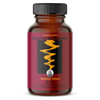About Shuyu Wan
Shuyu Wan was first mentioned 1,850 years ago as part of the important chapter on Deficiency Taxation in Zhang Zhongjing’s classical formula primer for complex disorders, Essentials from the Golden Cabinet (Jingui yaolüe). With 21 ingredients, almost all of them categorized as “top level herbs” in The Divine Husbandman’s Classic of Materia Medica (Shennong bencao jing), it is one of the most complex classical formulas on record. Although the remedy is not listed anymore in most modern formula textbooks, it should be regarded as the origin of the extremely relevant method of “enhancing immunity while eliminating external pathogens” (fuzheng quxie). Many chronic disorders characterized by the threefold combination of deficiency, wind and stagnation (qi/Blood stasis) can be treated with this prescription. The Jingui itself, reiterating the Yellow Emperor’s Classic of Medicine (Huangdi neijing) stance on the detrimental influence of wind pathogens, lists Shuyu Wan as the mother remedy “for all types of disorders caused by the combination of various deficiencies induced by poor lifestyle, chronic wind and stuckness of qi”. The elaborate formula contains within in it several other remedies, all of which are better known nowadays than Shuyu Wan itself; most notably Guizhi Tang (Cinnamon Decoction), Zhi Gancao Tang (Baked Licorice Decoction) and Bazhen Tang (Eight Treasure Decoction). As the formula’s title proclaims, the most prominent feature of Shuyu Wan is the lead herb Shuyu, now called dioscorea. Shuyu literally translates as “Giant Tuber that Cures Everything” or “Gigantic Root that Nourishes Reserves”. It is perhaps the blandest of all Chinese herbs. As a result, it has become a treasured food grade qi tonic in everyday Chinese cooking and is regarded as a safe and effective tonic for children suffering from weak digestion. Modern research has shown that Shanyao is rich in vitamins, polysaccharides, amino acids, calcium, copper, zinc and other trace minerals—a natural equivalent to a modern multi-nutrient supplement formula. In addition, Shanyao is valued as a cosmetic herb that can moisturize the skin and provide structure and firmness to the connective tissue. Since 40% of the remedy is composed of the bland and sweet food ingredients dioscorea, jujube dates, and licorice, it can be used as a base remedy for all Spleen qi deficiency disorders accompanied by the related pathologies of wind, damp and stagnation. Due to its complex design, however, Shuyu Wan is not limited to the treatment of digestive system issues. It is just as often prescribed for chronic disorders of the respiratory system, the circulatory system, and the urinary system. Clinical case studies have particularly emphasized the beneficial effect of the remedy in the recovery from chemotherapy and/or radiation. Shuyu Wan, moreover, exhibits a high degree of alchemical stability and deliberately balances the herbal functions of heating and cooling, moistening and drying, and consolidating and dispersing. The formula is therefore exceptionally suitable for chronic disorders that require long-term treatment and a gentle/gradual approach to tonification.
Therapeutic Principles
- Tonify qi and Blood and reverse chronic exhaustion
- Eliminate deep-seated wind pathogens
- Move stagnation and harmonize up-down qi dynamics
Formula Ingredients
NOTE: The traditional ingredient Ejiao (donkey hide gelatin) has been replaced with Shu Dihuang Tan (carbonized, cooked rehmannia). This substitution preserves a threatened natural resource.
| CHINESE | PINYIN | COMMON NAME; PAOZHI (PROCESSING) | AMOUNT |
| 山藥 | Shanyao | Dioscorea | 10.24% |
| (川) 當歸 | Danggui | Tang-kuei, Sichuan | 3.40% |
| 桂枝 (尖) | Guizhi | Cinnamon twig | 3.40% |
| 神曲 (麩炒) | Shenqu | Massa fermentata; bran fried | 3.40% |
| 生地黃 | Sheng Dihuang | Rehmannia, raw | 3.40% |
| 豆黃卷 | Douhuangjuan | Soybean sprouts | 3.40% |
| 甘草 (棗花蜜炙) | Zhi Gancao | Licorice; jujube flower honey baked | 9.55% |
| 黨參 | Dangshen | Codonopsis | 2.39% |
| 川芎 | Chuanxiong | Ligusticum | 2.05% |
| 白芍 | Baishao | Peony, white | 2.05% |
| 白朮 (麩炒) | Baizhu | Atractylodes, white; bran fried | 2.05% |
| 麥門冬 | Maimendong | Ophiopogon | 2.05% |
| 杏仁 (清炒) | Xingren | Apricot seed; fried | 2.05% |
| 柴胡 | Chaihu | Bupleurum | 1.70% |
| 桔梗 (蜜炙) | Jiegeng | Platycodon; honey-baked | 1.70% |
| 茯苓 | Fuling | Poria | 1.70% |
| 熟地黃 (炭) | Shu Dihuang | Rehmannia; wine steamed and carbonized | 2.40% |
| 乾薑 | Ganjiang | Ginger, dried | 1.03% |
| 白蘞 | Bailian | Ampelopsis | 0.70% |
| 防風 | Fangfeng | Saposhnikovia | 2.05% |
| 大棗 | Dazao | Jujube | 39.30% |
Shuyu Wan Usage
Companion Remedies
SUITABLE FOR COMBINING
Similar Remedies
ALSO TONIFY QI AND/OR BLOOD AND/OR ELIMINATE CHRONIC WIND PATHOGENS; ALTERNATION OPTIONS
Supplement Facts
- Serving size: 3 capsules
Servings per contains: 30
Amount per serving: 1200 mg
*Proprietary blend containing pure herbal extracts of:
Ziziphus jujuba fruit (Dazao), Dioscorea oppositifolia rhizome (Shanyao), Glycyrrhiza glabra root honey baked (Zhi Gancao), Massa fermentata bran fried (Shenqu), Cinnamomum loureirii twig (Guizhi), Angelica sinensis root (Danggui), Glycine max sprout (Douhuangjuan), Rehmannia glutinosa root tuber (Sheng Dihuang), Rehmannia glutinosa root tuber processed (Shu Dihuang), Codonopsis pilosula root (Dangshen), Atractylodes macrocephala rhizome bran fried (Baizhu), Ligusticum chuanxiong rhizome (Chuanxiong), Paeonia lactiflora root (Baishao), Saposhnikovia divaricata root (Fangfeng), Ophiopogon japonicas root tuber (Maimendong), Prunus armeniaca seed (Xingren), Bupleurum chinense root (Chaihu), Wolfiporia cocos sclerotium (Fuling), Platycodon grandiflorum root (Jiegeng), Zingiber officinale rhizome (Ganjiang), Ampelopsis Japonica root (Bailian)
* % Daily value not established
Other ingredients: living green clay excipient, vegetable capsule






